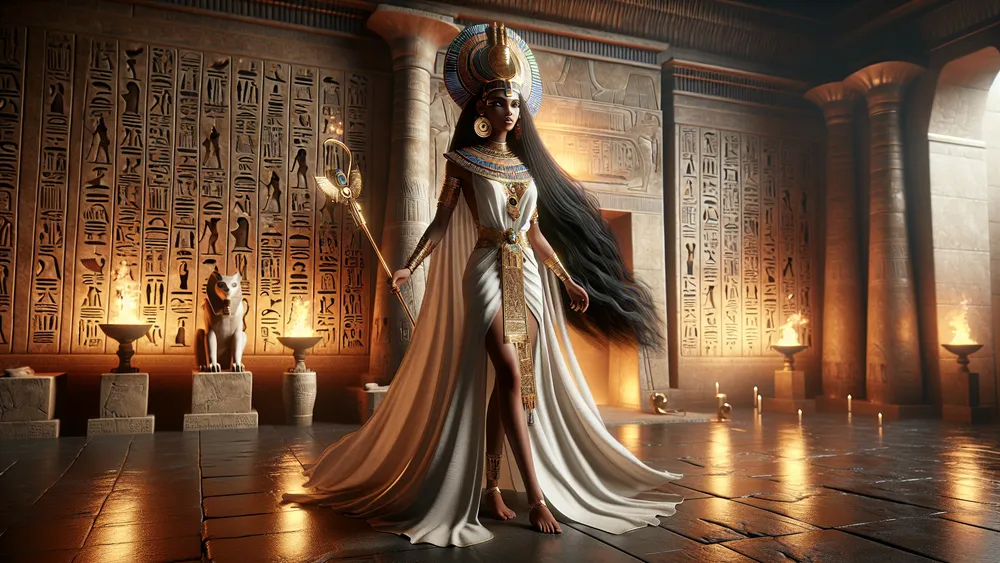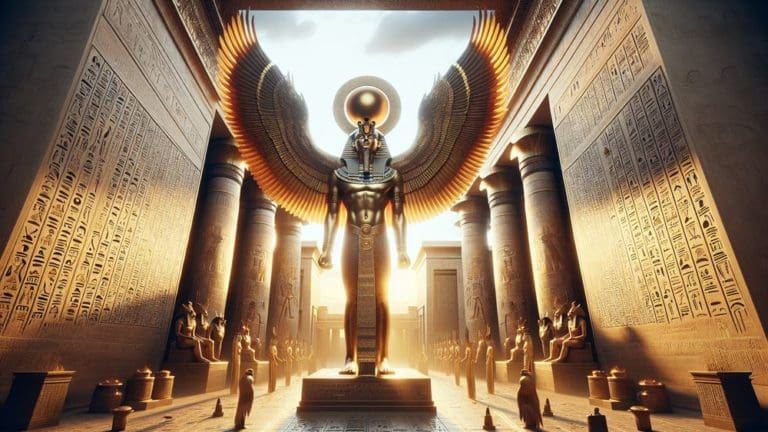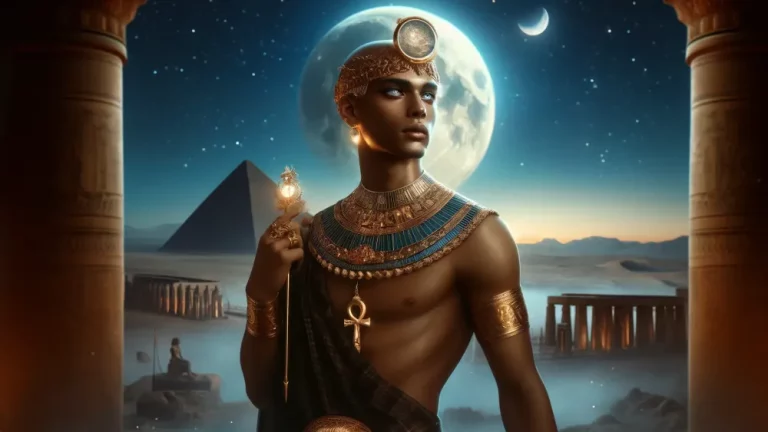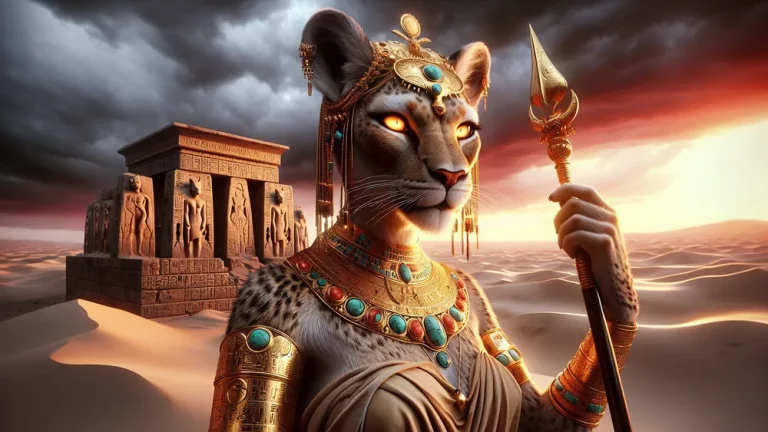Hemsut: Goddess Of Fate And Protection
Welcome to our look at Hemsut, the interesting goddess of fate and protection in Egyptian mythology. Picture a figure who not only forms the destiny of people but also stands as a protector against the unknowns of life – this is Hemsut. In this piece, we will talk about her beginnings, what her roles are, and why she matters in ancient Egyptian life. First, knowing her, what makes her special, and her signs.
Key Points:
- Hemsut: Goddess of fate and protection in Egyptian mythology.
- Origins: First mentioned in Pyramid Texts and Coffin Texts during the Old Kingdom period.
- Roles: Decides fate and keeps people safe, often shown holding a staff and an ankh.
- Worship: Called upon in rites for safekeeping and direction, linked with birth and fate.
- Art and Texts: Depicted in art holding symbols of protection, mentioned in various ancient writings.
- Legacy: Still of interest in modern spiritual activities and pop culture, respected in neo-pagan and reconstructionist groups.
- Scholar Insights: Studied by scholars like Dr. Emily Teeter and Dr. Geraldine Pinch for her dual role in fate and safety.
Then, we’ll go through her mentions in history and how she changed over time. Learning her power on fate and how people called to her for protection follows. We also will look at other gods, how she was worshipped, and how she is shown in art and old texts. Lastly, we’ll look at her impact today and what scholars think about her.
Whether you are new to mythology to a seasoned enthusiast, this journey through the life and legacy of Hemsut should be informative and interesting.
Hemsut: Overview and Key Facts
| Main Info | Description |
|---|---|
| Name | Hemsut (also written as Hemuset or Hemuset) |
| Role | She decides fate and keeps people safe |
| Traits | Known for holding a staff and an ankh, items of power and life |
| Signs | Staff, ankh, and sometimes a shield or item for safety |
| First Mentions | Found in Pyramid Texts and Coffin Texts from the Old Kingdom time |
| Importance | Represents the idea of fate, savior of people and kings |
| Worship | Called upon in rites for safekeeping and direction, often linked with birth and fate |
| Seen in Art | Shown as woman holding staff and ankh, sometimes with safety signs |
| Historical Change | Role and importance changed from Old Kingdom to later times, showing shifts in beliefs |
| Today’s Impact | Still of interest in modern spiritual activities and pop culture |
Getting to Know Hemsut
To really get Hemsut’s part in Egypt stories, let’s look into who she is, where she started, and the meaning she had in old times.
Who is Hemsut?
Hemsut is a key figure in Egyptian mythology, looked up to as the goddess of fate and protection. Think of her as a god-like power forming people’s fates and being a safeguard against life’s unknowns. Why she matters is because she does two things: She is the idea of fate, affecting what happens in life, and she gives safety, keeping both people and king’s safe.
To picture her better, Hemsut is often shown with certain items and signs that show her power. These are:
- Scepter: This means authority and strength.
- Ankh: This means life and living forever.
- Protective Amulets: Sometimes shown with shields or other things for safety.
Knowing these things helps you understand the big effect Hemsut had on old Egyptian beliefs and ways.
Understanding Hemsut’s role in Egyptian mythology is crucial because she represents fate and protection, influencing events in life and safeguard both individuals and rulers.
Where Did Hemsut Come From?
Hemsut first appears in Pyramid Texts and Coffin Texts from the Old Kingdom period of old Egypt, around 2400-2100 BCE. These writings on tomb walls to keep the dead safe often call on Hemsut as a fate power. In these mentions, Hemsut is a strong god who could change what happens to both alive and dead, making sure they are okay in the afterlife.
This important part made her a main figure in the group of Egyptian gods and goddesses. As years went by, what Hemsut did and why she mattered changed, showing how Egyptian society and ways of worship changed.

In the Middle Kingdom (around 2050-1710 BCE), her traits as a protector became clear, and people often called on her in rites to keep them and kings safe. During the New Kingdom time (around 1550-1070 BCE), Hemsut‘s power grew, and sometimes she was connected with other safety gods, making her more important in the gods’ group.
Praying to Hemsut also changed, with new places and ways to honor her. These changes show how Hemsut‘s job as a goddess of fate and protection was not fixed, changing to fit what old Egyptians needed spiritually over time.
What Hemsut Did in Egyptian Myths
To see Hemsut‘s deep effect on old Egyptian way of life, we should look at tales and stories that show her control of fate and her safety powers.
Hemsut and What She Means for Fate
In old Egyptian belief, fate, called “Shai,” was viewed as a set path affected by divine powers, and Hemsut was a key example of this idea. People thought she had the power to shape lives, making sure their paths matched the divine plan. Several tales and stories show Hemsut’s role in fate, where she steps in to lead or change events. For instance, in the Pyramid Texts, Hemsut is called to guide the pharaoh’s fate in the afterlife. Other stories show her as a destiny protector. Some important examples are:
- Pyramid Texts: Hemsut is called to guide the pharaoh’s fate in the afterlife.
- Coffin Texts: She is shown affecting the fates of the dead.
- Temple Inscriptions: Hemsut is seen as a protector of the fate of people and the state.
These stories show how Hemsut was crucial to the ancient Egyptian view of the world, showing divine control over fate and destiny.
How Hemsut Protects Us
Hemsut as a protector and guard was a main part of her self in old Egyptian stories. People thought she kept others from harm and made sure they were healthy, much like a helper angel today. Old Egyptians called on Hemsut for safety through many ways, such as prayers, ceremonies, and writings on charms and graves.
For example, in the Coffin Texts, Hemsut is called to protect the dead in their trip to the afterlife, making sure they are safe from bad powers. In temple writings too, she is shown as a holy shield for the pharaoh and the state, keeping them safe from foes and bad luck.
By knowing these ways, you can see how Hemsut’s safety traits were part of daily life, giving a sense of safety and divine watching over.

Hemsut Compared to Other Gods
Hemsut is a goddess of fate and protection and is like other Egyptian gods, for example, Shai, Meskhenet, and Isis, though each one has their own unique traits that make them different. Shai is an example of fate and destiny like Hemsut but shown as a male god.
On the other hand, Meskhenet is the goddess of childbirth and destiny, looking over the fate of people from when they are born. Both Hemsut and Meskhenet influence fate, but Meskhenet’s part is more focused on birth and starting new. Isis is a famous goddess of protection, magic, and motherhood and shares protective traits with Hemsut, though she is mainly known for her magic ability and care of mothers.
These differences show the various ways old Egyptians understood and respected the forces of fate and protection.
Here is a table to show how they are alike and different:
| Deity | Part in Fate | Role in Protection | Unique Traits |
|---|---|---|---|
| Hemsut | Influences destiny and fate | Guardian of people and state | Often shown with symbols of fate and protection |
| Shai | Example of fate and destiny | Small protective part | Male god directly linked with fate |
| Meskhenet | Looks over fate at birth | Protector of babies and mothers | Goddess of childbirth and destiny |
| Isis | Small role in fate | Strong protector, mainly in magic and motherhood | Famous for magic skills and care of mothers |
Seeing these gods side by side, you can understand how Hemsut’s part fits into the larger picture of Egyptian mythology, giving a special mix of fate and protection that fits well with the parts of other gods and goddesses.
How People Worshipped Hemsut
After looking at Hemsut’s jobs and why she’s important, look into how old Egyptians showed respect to her.
Temples and Special Places
Key temples and holy places for Hemsut were very important in old Egypt. For example, the Temple of Karnak is a well-known site where Hemsut was respected along with other gods in the large complex. The big buildings at Karnak, with their tall columns and detailed carvings, show how important Hemsut’s worship was.

Another site to mention is the Temple of Esna, where writings and pictures show Hemsut’s role in the holy order. These temples, much like today’s big cultural sites, were center spots for group worship and ceremonies, showing how much old Egyptians respected Hemsut. Visiting these places, people could connect with the holy and ask for Hemsut’s help in protection and guidance.
Temples in ancient Egypt, like the Temple of Karnak and the Temple of Esna, were central for worshipping the goddess Hemsut and seeking her guidance and protection.
Rituals and Things People Offered
In old Egypt, ceremonies and things people gave to Hemsut were important to get her goodwill and safety. Prayers and songs said at sunrise and sunset were usual activities, asking for Hemsut’s good things for the day or safety through the night. They gave food, drinks, and small statues, showing food and loyalty.

For example, people often gave bread and beer, showing food and the stuff of life, just like how people today might light candles or give flowers in a holy place. These things people gave were put on special tables or spots in temples, and incense burned clean the place and make the goddess happy.
These activities were to honor Hemsut and to get her help in matters of fate and safety, so her holy influence would shape their lives in good ways and keep them safe from harm.
Hemsut in Art and Stories
After looking at the ceremonies and things given for Hemsut, now focus on how she is shown in old Egyptian pictures and stories.
How Artists Showed Hemsut
Old Egyptian pictures often show Hemsut as a woman with a hat, decorated with a shield and crossed arrows, show her protective side. She sometimes holds an ankh, the thing for life, or a stick, showing her power over life and fate.

In the Temple of Karnak, you can find pictures of Hemsut with other gods, showing her as an important part of the group of gods. Another work is a stone slab from the Middle Kingdom, where Hemsut is seen giving good things to a pharaoh, which shows her control over the ruler’s destiny. These pictures, like today’s images of important people, showed her god-like features and the respect the old Egyptians had for her.
Where Hemsut Shows Up in Old Texts
In many important old Egyptian writings, Hemsut is talked about. These talk about her part and why she mattered. One main case is the Pyramid Texts, where they asked Hemsut to give the pharaoh a good destiny after death. These writings, on the walls of pyramids, were like religious guides for the dead, much like today’s holy books give spiritual guidance.
Another important mention is in the Coffin Texts, where they call on Hemsut to protect the dead and make sure they have a safe journey to the afterlife. Also, in the Book of the Dead, a group of spells and sayings, there are calls to Hemsut for safety and good luck.
These mentions show Hemsut’s important part in the holy and religious life of old Egyptians, showing her effect over fate and safety in both life and death.
Hemsut Today and Her Legacy
We looked into Hemsut’s pictures in art and the talks about her in old writings. Now, see how her mark still affects culture and beliefs today.
How Hemsut is Seen in Today’s World
Today, Hemsut shows up in media and culture in different ways. She is seen in stories and graphic stories that use Egyptian myths, like Rick Riordan’s “The Kane Chronicles,” where old gods are made new for today’s people.
In computer games like “Assassin’s Creed Origins,” Hemsut and other Egyptian gods are made real, letting players interact with these old figures in a computer setting. Outside of media, Hemsut’s effect reaches into today’s spiritual ways, mainly in neo-pagan and reconstructionist groups, where she is respected as a goddess of fate and safety.
These people often use signs linked with Hemsut, like the ankh and scepter, in their ceremonies and shrines, like how people today might use signs of luck or safety in their lives. This today’s respect shows Hemsut’s lasting mark and her continued importance in the spiritual world.

What Scholars are Saying about Hemsut
Recent studies have showed Hemsut’s part and importance in Egyptian stories. Scholars like Dr. Emily Teeter and Dr. Geraldine Pinch have looked at Hemsut’s two sides as a goddess of fate and safety, showing her unique spot within the group of gods.
Their studies, which they often print in journals like the “Journal of Egyptian Archaeology,” show that Hemsut was a protector of people but also a godly power changing the fate of whole groups. For example, Dr. Teeter’s examination of temple writings says that Hemsut was called upon during big events, much like how modern nations might ask for godly help during national events.
These results show the many-sided nature of Hemsut’s praise and her lasting effect on both personal and group levels. This research helps us know the reach of Hemsut’s power and gives a better view of her value in old Egyptian religion.
Hemsut and Other Egyptian Gods
The Egyptian group of gods is a rich mix. Each with their own special jobs and traits, making a hard and linked divine level. Hemsut holds a unique place. As goddess of fate and protection, she often works together with other gods to change both people’s futures and bigger worldly things.
For example, while Hemsut rules fate, gods like Ma’at watch right and fairness, showing how different gods’ areas mix to keep order. To look at the full list of all Egyptian gods and understand their connections, you can refer to this complete list of all the Egyptian gods.
This link shows the team of the Egyptian gods, where each god’s power adds to and helps others, making a smooth divine rule.
FAQs
1. Who were the parents of Hemsut?
The parents of Hemsut are not explicitly mentioned in ancient Egyptian texts, making her origins somewhat ambiguous.
2. How was Hemsut worshipped in ancient Egypt?
How Hemsut was worshipped in ancient Egypt involved rituals and offerings that invoked her protection and influence over fate.
3. What symbols are associated with Hemsut?
Symbols associated with Hemsut include the scepter and the ankh, which represent her divine authority and life-giving power.
4. Are there any modern-day practices that honor Hemsut?
Modern-day practices that honor Hemsut are rare but can be found in certain neo-pagan and spiritual communities.







